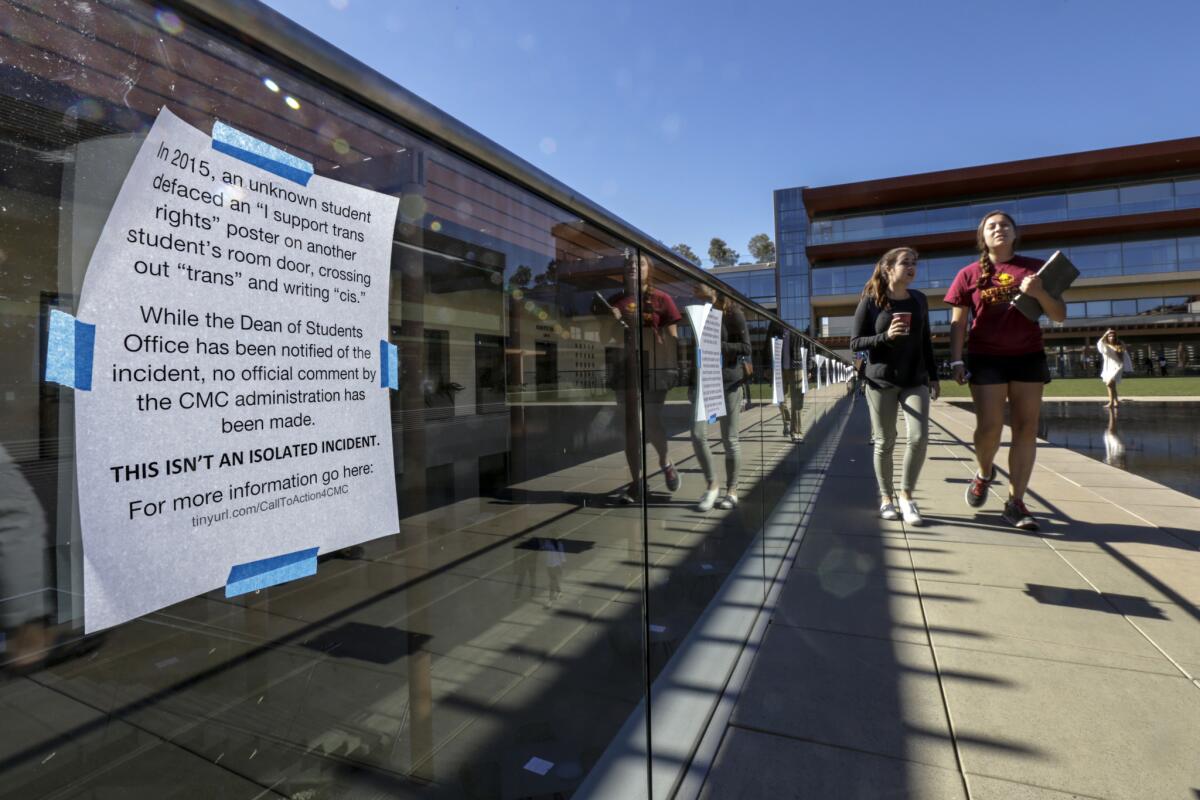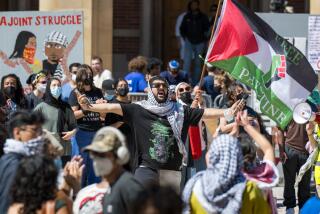Claremont McKenna College students embrace a lesson in activism

Numerous flyers printed with students personal experiences of racism on campus are posted around Claremont McKenna College.
- Share via
Student leaders at Claremont McKenna College on Friday savored their victory at the departure of a high-ranked administrator deemed insensitive to minorities and won promises that the liberal arts school would seek to add more diversity among faculty and staff.
Their win, after protest rallies and two students’ hunger strikes, was particularly relished at a school that has been traditionally more politically conservative than many other colleges around California. For some older alumni, “CMC” was seen as a jumping-off place into Republican political careers and business success, not a campus hosting the activism more often seen at UC Berkeley or UC Santa Cruz.
“It’s incredibly surprising that this is something students of marginalized identities have been able to do on our own,” said Jincy Varughese, a senior who helped start the CMCers of Color activist group this year. “Before, the message in the classroom and dorm rooms was that we were not empowered,” said Varughese, who was born in India and raised in Houston.
The campus, roiled by student protests earlier this week, was quiet Friday as students in shorts and T-shirts soaked up the sun, chatted and read books. Few seemed to take notice of the many unsigned fliers taped to buildings, windows and even toilet stalls describing acts of bias experienced at Claremont. They included vandalism at the Queer Resource Center, defacement of Black Lives Matter posters, racial slurs and perceived mockery of their cultures.
Their protests came to a head Thursday with the resignation of Dean of Students Mary Spellman, who had angered students with her email to a Latina student saying she would work to serve those who “don’t fit our CMC mold.” Spellman later apologized. Her remarks galvanized minority students who said they have long sought more funding for multicultural services and other changes, although not all the student activist groups called for her resignation.
In the wake of the protest, campus president Hiram Chodosh announced a package of reforms aimed at increasing diversity, adding staff to better mentor students from various backgrounds and setting aside a physical space where issues of inclusivity, civil rights and free speech can be discussed.
Protest leaders said Friday they would press to make sure the promises are actually kept and push for more, such as a requirement for a course on diversity.
“We’re hopeful but wary,” said Aaron McKinney, 20, a physics and psychology major who co-leads an African American campus group.
Chodosh said in an interview Friday that many of the changes he announced after this week’s protest had been previously under consideration and that he regretted that the school had not moved faster. He said the protests “accelerated” the reforms.

Two Claremont McKenna College students describe experiences on campus they say made them feel marginalized.
Chodosh said he felt “tremendous sorrow for the slow changes in every part of my life, in every part of our community,” in the same way he feels sorrow for economic inequities in American society.
The campus president said it would be wrong to blame the furor just on Spellman’s email comment. “It is more important to focus on the underlying dynamics and to realize the challenges the students are bringing to everyone’s attention are societal challenges and national challenges and we have our own iterations on our campus. It’s not a single email. It’s a shared collective responsibility,” he said.
Chodosh also pledged to work to maintain free speech on campus from all sides. He noted that Claremont McKenna appears to have more conservative and middle-of-the-road faculty and students than some other colleges around the country. “I think we have an extremely beneficial political balance in our college. And we cherish the political diversity on our faculty, which is sadly lacking in other institutions.”
This week’s political activism at Claremont McKenna College may jolt some alumni who recall it as the most politically conservative and business-oriented of the seven schools at the Claremont Colleges consortium. In fact, in 1999, when the college hired former Duke law school dean Pamela Brooks Gann as president, the buzz was less about her being the first woman leader at the campus and more about her having leanings toward the Democratic Party.
Claremont McKenna’s reputation in the past as a more conservative school than its neighbors comes in part from some prominent alumni, including former Republican Rep. David Dreier and Rob Hurtt, the former state Senate Republican leader.

Claremont McKenna College President Hiram Chodosh discusses intellectual goals for students.
The school was founded in 1946 as Claremont Men’s College, primarily for World War II veterans who had tuition paid through the G.I. Bill. It was meant in part as an enrollment counterweight to the older Scripps College next door, which remains a women’s school today. “CMC” went co-ed in 1976 and changed its name five years later to Claremont McKenna in honor of industrialist Donald McKenna, who was a major donor. While the world “men’s” was gone from the college, people still were able to maintain the nickname “CMC.”
Kaylilani Minami, 20, said the student activism has already begun to change the campus climate. In a recent government class, the professor announced she would deviate from her syllabus for the first time in 16 years and allow students to discuss the race issues that have roiled the campus. Minami, a junior, said several white students asked how they could be allies and said they had never been conscious before of how marginalized some students felt.
“The response was really great,” she said.
Minami said she realized the need for more campus resources for minority students in her freshman year. A government professor, talking about how Capt. James Cook was killed by native Hawaiians, joked that it was not the paradise then that it is now, spurring laughter in the class.
But Minami, of Hawaiian descent, said she was stung by the insensitivity to how Cook and other whites had savaged her people and homeland. “It was horrible,” she said. “I felt so isolated, like my identity was being diminished and my whole culture and ancestors’ struggles were just a joke.”
Experts said protests at CMC are part of a wider trend that started with the Black Lives Matter movement and was brought to wide attention at the University of Missouri, where the football team’s threat to strike unless racism was addressed there led to the resignation of two top leaders.
“I do think this is a national trend. There is a new kind of activism that is really calling to us,” said Miriam Feldblum, Pomona College’s vice president and dean of students.
“There is no doubt that students of color, black students are facing the realities and legacies of institutional racism on and off campus. And it’s really important for colleges and universities to grapple with this,” Feldblum said.
The Claremont McKenna protesters said most of their fellow students have been supportive but anonymous posters on the Yik Yak social media site have accused them of trying to foment a race war or tried to silence them.
Michaiah Young, a sophomore majoring in economics and neuroscience, said they are not aiming to stir up conflict but to facilitate more open conversations about race, gender and identity, as touchy as that may be. “We all need to listen to each other,” Young said.
She and McKinney said they mainly love their college experience, despite some culture shock at leaving heavily minority high schools for the more heavily white, affluent Claremont. They are active in such campus pursuits as Bible study, skateboarding and pole vaulting.
“This place is my paradise but it hurts to know there are students here who found a different experience,” McKinney said.
Andrew Meehan, a management engineering major, said he was startled by the speed of events that led to Spellman’s resignation. But he said he supported the students.
“CMC is often stereotyped as West Coast Wall Street students,” said Meehan, who is white. “It draws a more conservative student with wealthier backgrounds. The structure of the school’s hierarchy is mostly white males all the way to the board of trustees. If you look at the board it’s mostly rich white guys. So from the top they’re not much aware of the issues people of color are facing.”
Meehan described himself as an affluent student whose father is a financial adviser and mother, a yoga teacher. But he said he supported the minority students in part because he was raised in Birmingham, Ala., and was steeped in the city’s significance in the civil rights movement. Speaking of Claremont minority students, he said, “If I had the issues they did, I would be outraged and they have the same right to be outraged too.”
For more education news, follow @teresawatanabe and @larrygordonlat
ALSO
Eagles of Death Metal band members said to be safe after deadly Paris hostage-taking
Man accused of shooting at cops disrupts court again
Dog facing euthanasia is taken from San Luis Obispo shelter; owner sought
More to Read
Sign up for Essential California
The most important California stories and recommendations in your inbox every morning.
You may occasionally receive promotional content from the Los Angeles Times.











